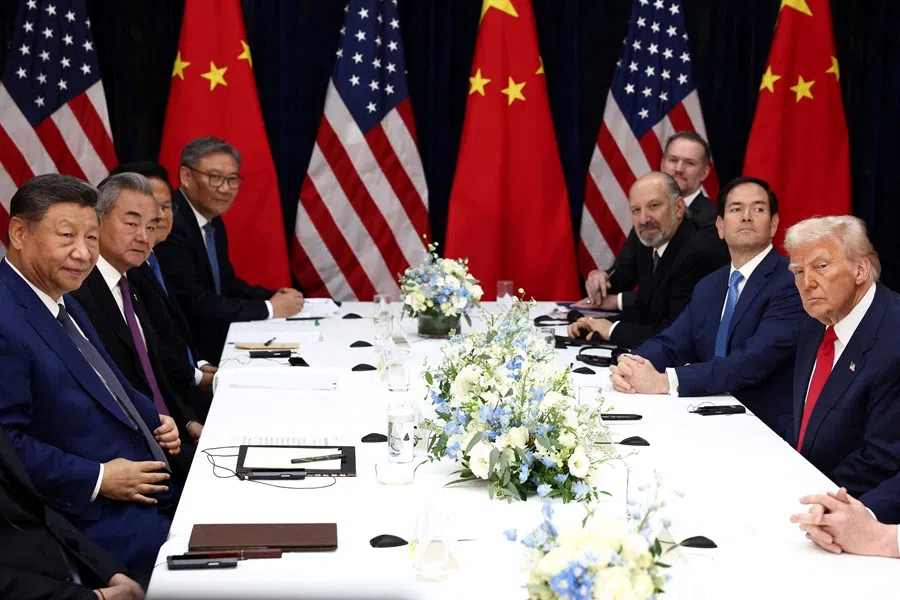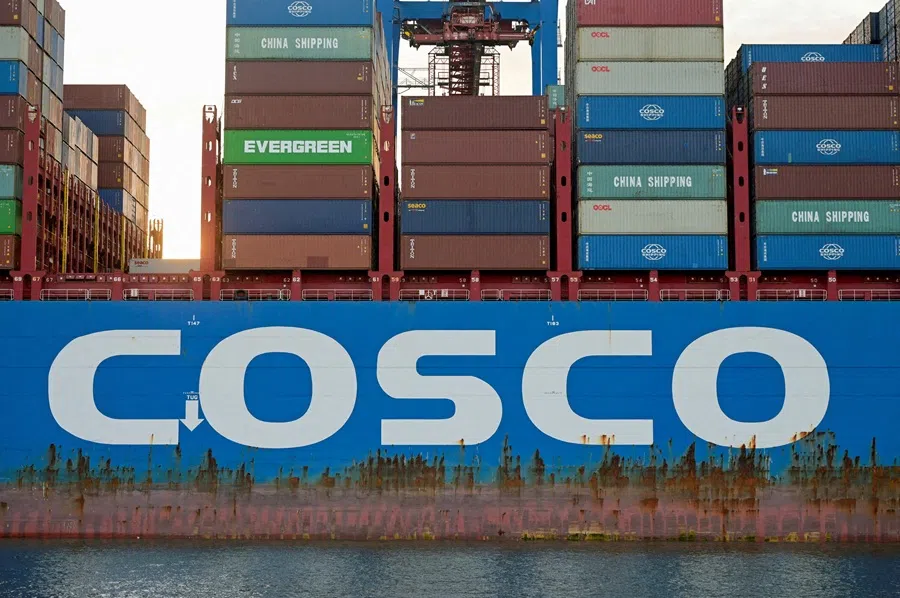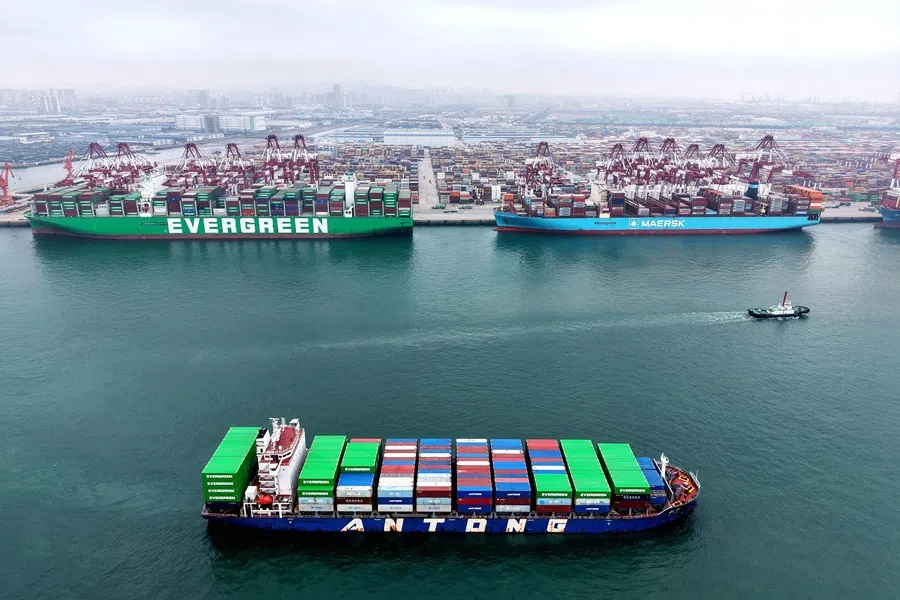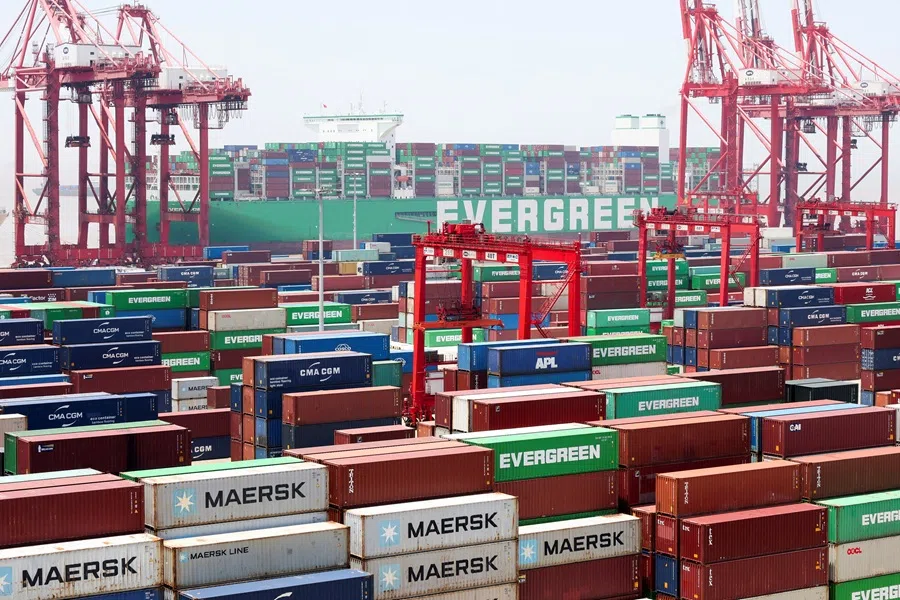The pause before the storm? US and China test control of the seas
The US and China have suspended their maritime feud — for now. Beneath the calm, both are manoeuvring for long-term control of the global commons, using trade rules, technology and statecraft to shape the next era of oceanic power, writes researcher Genevieve Donnellon-May.

The US–China maritime dispute entered a brief period of calm on 30 October, when both sides agreed to suspend port fees and related maritime measures for one year. This marks the first meaningful de-escalation in a domain that has become a central theatre of economic and strategic rivalry. The pause follows months of escalating tensions in which both countries used regulation to impose costs, signal political intent, and influence global trade.
Under the agreement reached in South Korea by US President Donald Trump and Chinese President Xi Jinping, US port fees on Chinese-built vessels — estimated at US$3.2 billion annually for large ships — will be suspended for 12 months, effective 10 November. China’s Ministry of Commerce confirmed it would remove corresponding port fees once the US suspension takes effect.
While the pause provides temporary relief for shipping operators and global supply chains, it does not resolve underlying disputes over regulatory authority, transparency or reciprocity. The central question remains: is this a genuine reset in maritime relations, or merely a pause before renewed friction?
Maritime regulation has evolved into a sophisticated tool of statecraft, enabling states to impose economic costs and signal political intent without direct confrontation.
Tit-for-tat measures
The tensions stem from regulatory moves on both sides. On 17 April 2025, the US Office of the Trade Representative announced new port service fees under Section 301 of the Trade Act of 1974, targeting Chinese-built, -operated or -flagged vessels, effective 14 October. These fees increased operating costs and showed US intent to monitor maritime access as part of its trade and national security strategy.

Central to the escalation was China’s 29 September State Council decree, which revised maritime transport regulations to authorise countermeasures against countries imposing “discriminatory” restrictions on Chinese operators, vessels or crew. By codifying retaliation in law, Beijing institutionalised a strategic approach to maritime regulation rather than relying on ad hoc measures.
On 10 October, China’s Ministry of Transport issued a retaliatory measure effective 14 October. It applied to ships owned or operated by US entities, those with 25% or more US ownership, ships flying the US flag, and US-built vessels. Few US-flagged ships operate in China, but carriers like Matson faced higher costs and potential access restrictions. The 25% threshold was also expected to extend to third-country vessels with ties to US entities, amplifying uncertainty for global operators.
As of late October, port fees had already cost operators, including China-based COSCO and US-based Matson, millions of US dollars and disrupted schedules, driving up shipping costs. The one-year suspension halts these measures temporarily but does not resolve disputes over authority or reciprocity.
Maritime regulation as a strategic weapon
Maritime regulation has evolved into a sophisticated tool of statecraft, enabling states to impose economic costs and signal political intent without direct confrontation. For China, this aligns with its strategy of becoming a strong maritime state (海洋强国), seeking to strengthen control over transport, logistics and shipping infrastructure while reducing vulnerability to foreign pressures.
Over the past decade, Beijing has tightened oversight of domestic ports and shipping firms and expanded influence abroad, financing, building and operating nearly 100 port projects under the Belt and Road Initiative, including major stakes in Greece’s Port of Piraeus and Pakistan’s Gwadar Port. These assets allow China to prioritise trade flows during disruptions, reroute goods through “friendly” ports, and maintain stable access to energy and raw materials, even as these hubs face growing international scrutiny.
Even under the one-year suspension, both legal frameworks — China’s codified countermeasures and US regulatory tools — preserve rapid escalation potential.

The 29 September State Council decree exemplifies this strategic approach. By codifying the right to retaliate against discriminatory foreign measures, Beijing institutionalised its ability to leverage maritime regulation as a tool of economic statecraft. While the US–China suspension provides temporary relief, China retains the legal and administrative tools to respond if the pause expires.
China’s shipping and shipbuilding sectors — over 50% of global shipbuilding output and roughly 30% of US containerised import capacity — remain insulated. In the first eight months of 2025, Chinese shipyards captured 53% of global ship orders by tonnage. State-linked firms such as China COSCO Shipping Corporation, China Merchants Group, China State Shipbuilding Corporation and Orient Overseas Container Line (OOCL) anchor China’s shipping and shipbuilding sectors, ensuring that strategic industries remain insulated from external shocks.
The US has also used maritime regulation strategically. Port fees, inspections and sanctions have been applied to control access, monitor Chinese operations and impose costs. In September 2019, the US Office of Foreign Assets Control sanctioned two COSCO subsidiaries allegedly transporting Iranian oil, lasting until February 2020, which triggered a nearly 30% spike in Middle East–East Asia freight rates. These cases illustrate the “grey zone” competition where regulation functions as a strategic weapon.
Even under the one-year suspension, both legal frameworks — China’s codified countermeasures and US regulatory tools — preserve rapid escalation potential.
Regional powers navigate the pause
The US–China maritime dispute remains fraught with risks. There is no enforcement mechanism; either side could reinstate port fees and related measures unilaterally. Domestic political cycles — including US elections and China’s economic priorities — could trigger renewed escalation.
The pause undoubtedly buys time. But technological developments and evolving regulatory standards mean maritime governance will remain contested even during apparent calm.

Tensions had already peaked before the 30 October agreement. On 14 October, China’s Ministry of Commerce sanctioned five US-based subsidiaries of South Korea’s Hanwha Ocean Company, citing their involvement in activities linked to the US Section 301 investigation — a trade law that allows Washington to act against what it deems unfair foreign trade practices. While the immediate economic impact was limited, the sanctions carried strong symbolic weight, demonstrating Beijing’s willingness to target US allies and warn of collateral consequences for supporting Washington’s containment strategies.
Emerging technologies add another layer of complexity. AI-driven logistics, vessel tracking, and data-sharing protocols could provide new instruments of strategic leverage, creating a potential “next frontier” of regulatory competition. The pause undoubtedly buys time. But technological developments and evolving regulatory standards mean maritime governance will remain contested even during apparent calm.
For regional economies, the suspension provides temporary relief but underscores enduring uncertainty. ASEAN and middle powers may use the window to push for clearer maritime norms or regional codes of conduct, while ports such as Singapore, Busan in South Korea, and Manila in the Philippines may face pressure to navigate conflicting US and Chinese requirements.
News of the suspension deadline has already affected behaviour: operators may delay US port arrivals to avoid millions in fees. Four COSCO and OOCL containerships scheduled for Los Angeles and Long Beach before 10 November — incurring US$50 per net tonne fees due to Chinese ownership — are now slow steaming in the Pacific Ocean, highlighting how companies are already adjusting operations to the suspension’s timeline.
More broadly, the complex China–US dynamics reinforce ongoing efforts by governments and companies to diversify supply chains and reduce dependence on single routes or suppliers, particularly on China.

More broadly, the complex China–US dynamics reinforce ongoing efforts by governments and companies to diversify supply chains and reduce dependence on single routes or suppliers, particularly on China. Japan and the European Union are investing in alternative ports and logistics infrastructure through initiatives such as the Overseas Infrastructure Investment and Global Gateway.
Similarly, India is pursuing trade and connectivity projects, including the development of Iran’s Chabahar Port and the India–Middle East–Europe Economic Corridor. While enhancing resilience, these measures may also dilute China’s influence over global trade routes, highlighting the unintended consequences of regulatory assertiveness and the complex interplay between strategic regulation and trade policy.
Breathing space, not a resolution
The 30 October one-year suspension provides a temporary reprieve in the US–China maritime dispute but does not address underlying strategic tensions. Maritime regulation has become a key instrument of statecraft, allowing both powers to impose costs, signal political intent, and shape global trade without direct confrontation.
While the pause allows diplomacy, supply chain adjustments, and regional coordination, political cycles, emerging technologies and ongoing regulatory competition mean the risk of renewed escalation persists. The suspension is a temporary breathing space, not a resolution. The real test will lie in how Beijing and Washington manage the maritime leverage that remains firmly in place.



![[Big read] Love is hard to find for millions of rural Chinese men](https://cassette.sphdigital.com.sg/image/thinkchina/16fb62fbcf055b710e38d7679f82264ad682ce8b45542008afeb14d369a94399)
![[Big read] China’s 10 trillion RMB debt clean-up falls short](https://cassette.sphdigital.com.sg/image/thinkchina/d08cfc72b13782693c25f2fcbf886fa7673723efca260881e7086211b082e66c)
